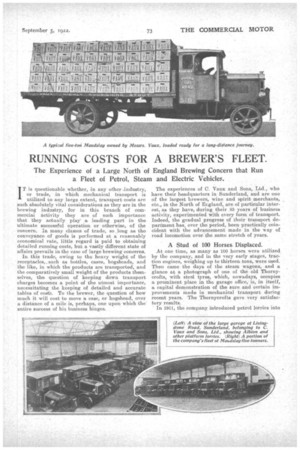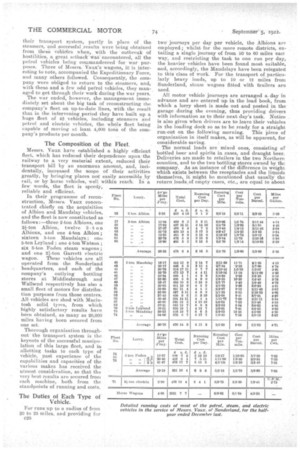RUNNING COSTS FOR A BREWER'S FLEET.
Page 11

Page 12

Page 13

If you've noticed an error in this article please click here to report it so we can fix it.
The Experience of a Large North of England Brewing Concern that Run a Fleet of Petrol, Steam and Electric Vehicles.
IT is questionable whether, in any other .industry, or trade, in -which mechanical transport is utilized to any large extent, transport costs are such absolutely vital consideration e as they are in the brewing industry, for in this branch of cornmercia,i activity they are of such importance that they actually play' a leading part in the ultimate successful operation or otherwise, of the concern. In many classes of trade., so long as the conveyance of goods is performed at a reasonably economical rate, little regard is paid to obtaining detailed running costs, but a vastly different state of affairs prevails in the case of large brewing concerns.
In this trade, owing to the heavy weight of the receptacles,. such as bottles, cases, hogsheads, and the like, in which the products are transported, and the comparatively small weight of the products themselves, the question of keeping down transport charges becomes a point of the utmost importance, necessitating the keeping of detailed and accurate tables of costh. To the brewer, the question of how much it will cost to move a case, or hogshead, over a distance of a mile is, perhaps., one upon which the entire suceess of his business hinges. ' The experiences of C. Vaux and Sons, Ltd,, who have their headquarters in Sunderland, and are one of the largest brewers, wine and spirit merchants, etc., in the North of agland, are of particular interest, as they have, during their 85 years of business activity, experimented with every form of transport. Indeed, the gradual progress of their transport departiment has, over the period, been practically coincident with the advancement made in the way of road locomotion over the same stretch of years.
A Stud of 100 HorsesDisplaced.
At. one time, as many as 100 horses were utilized by the company, and in the very early stages, tra,cLion engines, weighing up to thirteen tons, were used. Then came the days of the steam wagons, and a glance at a photograph of one of the old Thornycrofts, with steel tyres, which, nowadays, occupies a prominent place in the garage office, is, in itself, a capital demonstration of the sure and certain improvements made in mechanical transport during recent years. The Thornyerofts gave very satisfactory results.
In 1911, the company introduced petrol lorries into their transport system, partly in place of the steamers, and .successful results were being obtained from these Veliieles when„ with the outbreak of hostilities, a great setback was encountered., all the petrol vehicles being commandeered for war purposes. Three of Messrs. Vaux's wagons, it is interesting to note, accompanied the Expeditionary Force, arid many others followed. Consequently, the company were obliged to return to the steamers, and, with these and a few odd petrol vehicles, they managed to get through their work during the war years.
The war ended, however, the management immediately set about the big task of reconstructing the company's fleet on up-to-date lines, with the result that in the intervening period they have built up a huge fleet of 42 vehicles, including steamers arid petrol and electric vehicles, the whole fleet being capable of moving at least 4,000 tons of the company's products per month.
The Composition of the Fleet.
Messrs. Vaux have established a highly efficient fleet, which has reduced their dependence upon the railway to a very material extent, reduced their transport bill by an enormous amount, and, incidentally, increased the scope of their activities greatly, by bringing places not easily accessible by rail, or by horse vehicles, well Within reach. In a few words, the fleet is speedy, reliable and efficient.
In their programme of reconstruction, Messrs. Vaux concentrated chiefly on the acquisition of Albion and Maudsla.y vehicles, and the fleet is now constituted as follows :-three 2-ton Albions, one 2#2-ton Albion, twelve 3 t on Albions, and one 4-ton Albion; sixteen 5-ton Maudslays; ono 5-ton Leyland; one 4-ton Watson ; six 5-ton Foden steam wagons ; and one 21-ton Garrett electric wagon. These vehicles are all operated from the Sunderland headquarters, and each of the company's outlying bottling stores at Middlesbrough and Wallsend respectively has also a small fleet of motors for distribution purposes from those centres. Allvehicles are shod with Macintosh solid tyres, from which highly satisfactory results have been obtained, as many as 20,000 miles having been secured from one set.
Thorough organization throughout the transport system is the keynote of the successful manipulation of this large fleet, and in allotting tasks to each type of vehicle, past experience 43f the capabilities and capacities of the various makes has received the utmost consideration, so that the very best results are secured from each machine, both from the standpoints of running and Costs.
The Duties of Each Type of Vehicle.
For runs up to a radius of from 20 to 25 miles, and providing for e28
two journeys per day per vehicle, the Albions are employed; whilst for the more remote districts, entailing a single journey of from 60 to 60 miles eact way, and restricting the task to one run per day, the heavier vehicles have been found most suitable, and, accordingly, the Maudsla,ys have been relegated to this class of work. For the transport of particularly heavy loads, up to 10 or 12 miles from Sunderland, steam wagons fitted with trailers are used.
All motor vehicle journeys are arranged a day in advance and are entered up in the load book, from which a lorry sheet is made out and posted in the garage during the evening, thus providing drivers with information as to their next day's task. Notice is also given when drivers are to leave their vehicles in the loading dock so as to be ready for a straight run-out on the following morning. This Piece of organization in itself makes, as will be apparent, for considerable saving.
The normal loads are mixed ones, consisting of bottled beer and spirits in cases, and draught beer. Deliveries are made to retailers in the two Northern eounties, and to the two bottling stores owned by the company. As an instance of the difference in weight which exists between the receptacles and the liquids themselves, it might be mentioned that usually the return loadsof empty eases, etc., are equal to about
two-thirds of the weight of the full load carried on thE outward run, thus proving that the beer itself is but a percentage of the weight of the load moved. Full loads are carried on all runs, so that there is no waste mileage. In addition to delivery work, the motor vehicles are used for transporting raw materials from the railway yard to the brewery.
The Accuracy Paid to Detail.
In view of the importance attaching to costs, Messrs. Vaux have in operation a most careful and accurate, but at the same time simple, method of
checking all char ges against their many vehicles, every item being worked out to the third decimal place, or to 1-1,000th of a penny. It will be noticed from the accomPanying tables that -none of the charges are assumed, as is the case in the cost. tables of numerous concerns operating motor vehicles on a large stale. As a matter of fact, Messrs. Vaux consider that 80 soon as any assumed figure is introduced the value, of the tables is lost, and the trouble spent in compiling them nullified. Therefore, all charges that are
entered are strictly accurate, and the manage ment considers that it can thus obtain an accurate indication of the cost of • the transport, either collectively or individually. To achieve this desirable state of affairs, each driver is supplied with a weekly sheet, which he fills up and returns to the office each Saturday. Here it is checked, summarized, and posted on to the summary sheet, which embodies all charges with the exception of maintenance and repairs. The latter are kept in a separate ledger, and at the end of each half-year, when the transport return is compiled, these are added to the summary table, and the eomplete cost of each lorry for the period is thus shown at a glance.
• Naturally, these records provide the company with a host of information not only with regard to the capabilities of the vehicles themselves, but also with .regard to the drivers as well. During the period covered by the accompanying costs tables, 19,588 tons were carried on outward journeys quite apart from return loads. The mileage was 107,000.
The Economy of the Electric.
In the case of the electric, our representative was given some highly interesting facts Find figures. It is used solely for in-town delivery work, a task formerly accomplished by horse wagons, and since its purchase it has been responsible for the reduction of costs on this class of work by well over 50 per cent. During the last two half-years in :which horse transport was relied upon, the average costs of delivery per barrel of beer were 4s. 0.75d. and 4s. 3.32d. respectively ; whilst for the half year under review, the electric had very materially reduced this figure to Is. 11.94d. This surprisingly low figure, added to the fact that, since its purchase, in October, 1920, the electric has only had one breakdown, namely, in the shape of a slight steering, gear defect, has made,
the vehicle indispensable. The motor vehicles are housed at a large garage in Sunderland, which was erected some two years ago, when the task of building up the fleet was being undertaken, and great attention is paid to cleanliness. The spacious interior allows plenty of room for thorough overhaul and testing.
Petrol is stored on the premises in a Bywater 2,000 gallon underground tank. Inspection pits and a "full range o2 tools and appliances are part and par
cel of the works equipment, and they enable defects to be remedied and repairs to be executed with the minimum of delay. Blaydon motor spirit is used for fuel, and it has been found to give most satisfactory results. Practically all repairs are done on the premises, and these, together with the general overhaul and care of the vehicles, are executed under the control of one petrol foreman, one snam wagon foreman, and three mechanics.
We publish, herewith, a specimen:4. copy of the costs against one of the Maudslays, for the half. year ended December last, the capital charges on which merit attention,, together with the precise costs for the fleet over the same period, the latter being a most interesting and cocaine statement. In studying
these costs, the bad state of the roads over which the vehicles are running daily, and also the heavy loads carried on all journeys, both outward and return, must be borne in mind. In view of the conditions of operation, however, the accompanying charges must be considered as most gratifying.
Half-year's Cost for 5-ton Maudslay.. Fleet No. 66.
Days running, 119. Repairs, 7. Laid off, 27. Holidays, 3.
Total miles, 5,063. Petrol, 918 gallons = 5•54 m.p.g. Total tons carried. Out, 543'9. In, 521-5 = 15,813 ton-miles. Equivalent barrels did, 3,429.






























